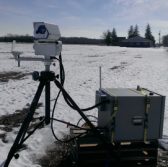 A team of scientists from the National Institute of Standards and Technology, Harris Corp. and Atmospheric and Environmental Research have developed a laser-based measurement system to monitor sequestered carbon over a mock storage site.
A team of scientists from the National Institute of Standards and Technology, Harris Corp. and Atmospheric and Environmental Research have developed a laser-based measurement system to monitor sequestered carbon over a mock storage site.
NIST said Wednesday the scientists reported they could discover underground gas leaks within a 16-foot radius regardless of wind conditions through a NIST-developed mathematical model that considers the change in shape of a gas leakage plume in the wind.
Zachary Levine, a physicist from NIST, said that through the discovery the agency aims to detect less intense leaks while it addresses spatial concerns and conduct more tests on additional field campaigns.
“What surprised us is that even though one of these experiments was meant to be one with no carbon source present, we found one anyway,†Levine said.
Harris and AER designed the laser-based measurement system under a cooperative agreement with the Energy Department‘s National Energy Technology Laboratory.
The scientists performed the study in support of efforts to find new methods to capture carbon dioxide gas and pump it deeper into Earth’s surface to reduce greenhouse gases in the planet’s atmosphere.




